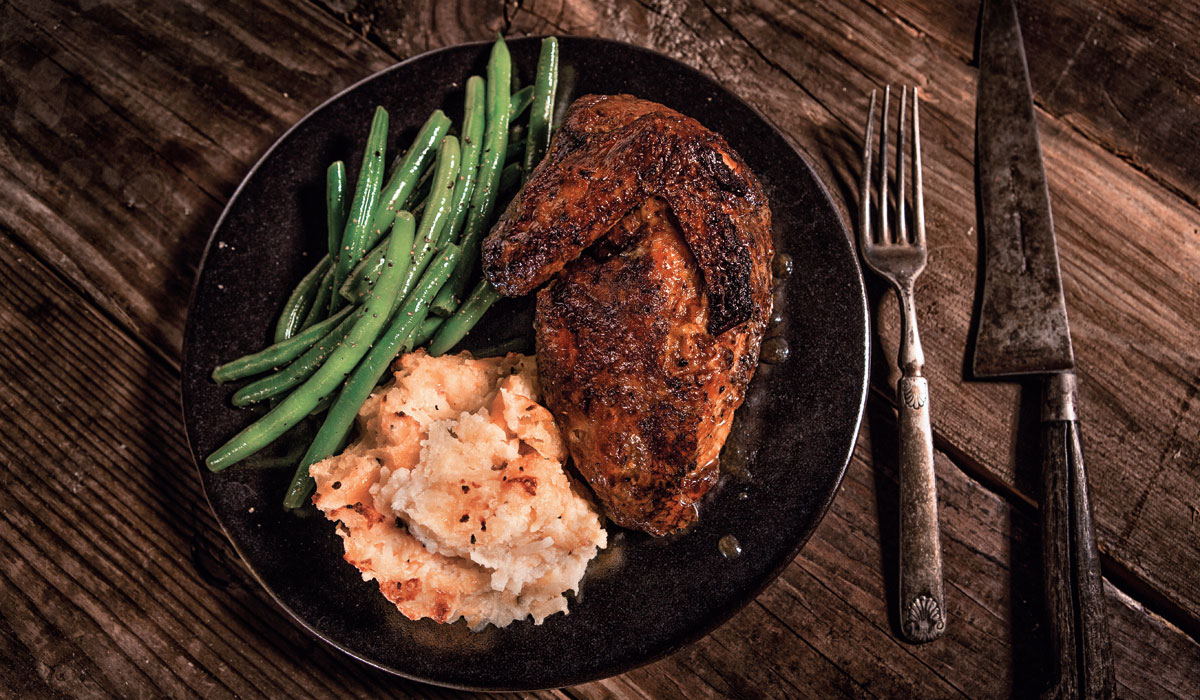When Sean Kennedy took over the business in late 2002, Cowboy Chicken, despite being a hometown Dallas favorite, had shrunk from three locations to just one. “[Phil Sanders] did a phenomenal job with the brand early on and built a lot of brand awareness in Dallas, but it really needed some structure,” Kennedy says of the cofounder.
But Kennedy, armed with a degree in restaurant hotel management from Texas Tech University and professional experience at the then-young Jason’s Deli brand, was primed to take on the challenge of growth again for the brand by building sales, implementing training procedures and manuals, enhancing the menu, and building a strong operations team.
In 2004, Kennedy and original partner Malcolm Menter opened a second unit, and later a third in 2008. The next year, the brand was ready to franchise.
Today, Cowboy Chicken has 26 units, seven of which were opened in 2018. A focus on the basics—great food, great hospitality, clean restaurants, and talented people—Kennedy says, is what led to the concept’s success the second go-round.
Unlike other chicken concepts, Cowboy Chicken’s bird, the focus of the brand, isn’t fried. The hormone- and steroid-free chickens are hand-seasoned in stores, then roasted on a wood-fired rotisserie that is proudly displayed in front of guests. “Everybody likes to watch chickens roasting over a fire,” Kennedy says. The result of the semi-open kitchen is a warm and rustic feel. High ceilings, open ductwork, and colorful art then add modern and welcoming touches throughout.
This new design was imagined in 2015 after a questionnaire the brand gave nearly 3,000 guests. “The resounding response was, ‘We love the food, but the atmosphere needs a little work,’” Kennedy says. “We launched our new prototype in 2016, which elevated Cowboy Chicken’s brand design to a level of ‘cowboy cool’ that can compete in all national markets.”
Cowboy Chicken
FOUNDERS: Phil & Jeanette Sanders and Elias Sacal
PRESIDENT/CEO: Sean Kennedy
HEADQUARTERS: Dallas
YEAR STARTED: 1981
ANNUAL SALES: $30 million-plus
TOTAL UNITS: 26
FRANCHISED UNITS: 20
With its signature wood-fired chicken, the brand has developed menu items like sour cream enchiladas, which are hand-rolled and topped with a homemade tomatillo sauce; Blue Ribbon Chicken Salad sandwiches; and BBQ Chicken Sandwiches. There’s also a range of chicken plates from Three Piece Dark (Kennedy’s favorite) to Crispy Drumsticks and half and whole chickens. That’s all served with Wild West Sides, like the popular Twice Baked Potaters hashbrown casserole, baked sweet potato, corn fritters, and fried okra (also a favorite of Kennedy’s—he likes it with a side of ranch for dipping).
“We think that homemade food is important,” Kennedy says. Not all the food at Cowboy Chicken is made from scratch from top to bottom, but a good deal of it is, beginning with fresh prep. “We try to balance that with ease of use, and we try to reduce the amount of labor required to do that by smart menu decisions,” he says. Like letting the star of its menu be the base of most other menu items.
Following a strong 2018, this year brings more changes for Cowboy Chicken, Kennedy says. New technology will be implemented to benefit operations and further grow sales, and the menu will be updated, too, as slow-moving items are replaced by more exciting options.
With many franchisees just getting started with one or two locations in each market, one can look forward to more Cowboy Chicken locations in 2019 as well.
“The Southeast and the West Coast are responding very well to this Texas brand,” Kennedy says. “We’ll continue that expansion.”
Having recently refined its expansion strategy to study stores that continually set a high benchmark, Kennedy is hopeful that real estate selection in these future stores will be excellent. But, generally speaking, high-density areas with a good deal of daytime population perform best. The brand’s demographic appeal is far reaching, Kennedy says, from men and women ages 25–65 to everyday workers and families with kids.
Cowboy Chicken also plans to continue to build corporate stores.
“I think it’s really important that we always keep corporate-owned and operated locations. I’m an operator by nature, but also the decisions we make for the brand affect the stores that we own and operate, too. That way, it aligns us with our franchisees. We’re all doing the same thing,” he says.
On top of growth geographically, the brand is also putting effort toward expanding its digital footprint. In 2018, it launched Pronto Pickup, a mobile app that has shifted the design of its new stores to be more convenient for customers picking up and for external delivery services. Third-party delivery drivers can easily grab the order and go without being obstructed by a traditional retail business. The tweak has boosted Cowboy Chicken’s off-premises sales.
As for any future hurdles, Kennedy is confident the brand can adapt. In fact, his favorite part of the job is tackling new challenges that come from different stages of growth. “The brand is always evolving, but the goal is always to serve the same great food and great hospitality in clean restaurants,” he says.

